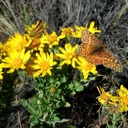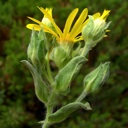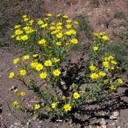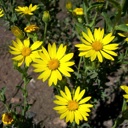|
|
 Flower heads Max Licher @http://swbiodiversity.org, Usage Rights: Creative Commons Attribution-ShareAlike (CC BY-SA) |  Leaf Patrick Alexander @http://swbiodiversity.org, Usage Rights: Creative Commons Attribution-ShareAlike (CC BY-SA) |  Bracts Max Licher @http://swbiodiversity.org, Usage Rights: Creative Commons Attribution-ShareAlike (CC BY-SA) |  Plant Max Licher @http://swbiodiversity.org, Usage Rights: Creative Commons Attribution-ShareAlike (CC BY-SA) | | |
|
Origin:
Native
Life Cycle:
Perennial
General Desc:
Resembles numerous other sunflower-like plants of the asteraceae family; identifying features include long, quite well-separated hairs along the leaf edges and the reddish-green stems, and the relatively large leaves that grow right beneath the flower.
Identification notes: The entire margins of the leaves bear firm, stiff hairs and the flowers are subtended by 1 to 4 leaf-like ovate to narrowly lanceolate bracts distinguishes this from Heterotheca villosa.
Height:
10 to 24 inches
Habitat Description: Riparian zones in ponderosa pine and Douglas fir forests, grassy clearings in ponderosa pine forest, lower spruce-fir zone, sandy riverbanks, roadsides, coarse sandy granitic soils with gravel, crushed lava gravelly soils, moist disturbed soils.
Plant Communities:
Montane Conifer Forest, Riparian, Disturbed Areas
Elevation: 4000 - 11000 feet
Color:
Bright yellow
Shape:
Daisy or dandelion-like in round clusters
Tubular:
N
Flowering Period:
Jun - Oct
Description:
Ray flowers usually number between 11 and 21, disc flowers between 26 and 66.
Leaf Color:
Green
Leaf Type:
Simple
Leaf Shape:
Round or oval
Leaf Margin:
Smooth
Leaf Attachment:
Alternate
Leaves Clasp:
N
Hairs:
Leaves
Spines:
N
Leaf Description:
Lanceolate, alternate, hairy, up to 2 inches long, tapering to a short spine. Relatively large leaves grow right beneath the flower-head, projecting out beyond the petals.
Fruit Color: Whiteish
Fruit Type: Achene
|
|




